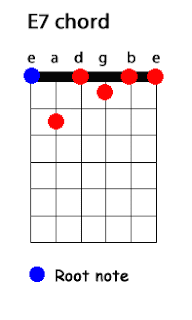What's up future rock stars!!!
In today's lesson we are going to take a look at a bit more advanced chords, don't worry they are just as easy to play as the average major and minor chord. We are going to take a look at the 7th chords, more precisely the major 7th, minor 7th and dominant 7th chords.
This is the first type of tetrad chords that we are going to discuss, this means that they differ from the normal triad because they contain a fourth note.
Major 7th chords
In today's lesson we are going to take a look at a bit more advanced chords, don't worry they are just as easy to play as the average major and minor chord. We are going to take a look at the 7th chords, more precisely the major 7th, minor 7th and dominant 7th chords.
This is the first type of tetrad chords that we are going to discuss, this means that they differ from the normal triad because they contain a fourth note.
Major 7th chords
Let's take a look at the major 7th chords first. You start off with a simple major triad, but you add a fourth note called a major 7th (which is the 7th note of that chords major scale, hence it's name).
The formula is: 1 3 5 7
Here are a few common shapes of this chord:
Emaj7: E G# B D#
Amaj7: A C# E G#
Dmaj7: D F# A C#
Gmaj7: G B D F#
Cmaj7: C E G B
Minor 7th chords
The minor 7th chord consists of the basic minor triad, but with an added
flat 7th note.
The formula is: 1 b3 5 b7
Here are a few common shapes:
Em7: E G B D
Am7: A C E G
Dm7: D F A C
Dominant 7th chords
The third type that we are going to discuss today is the dominant 7th chord, just like the major 7th it starts with a major triad, but this one also contains
a flat 7th note, whereas the major 7th contains a major 7th note.
Here are a few common shapes:
E7: E G# B D
A7: A C# E G
D7: D F# A C
G7: G B D F
C7: C E G Bb
note: most of these shapes can be moved around on the fretboard by turning them into barre chords, especially the E7, A7, Em7, Am7 and Cmaj7 are very easy to move around.
I hope this lesson helped you out.
If you have any questions, e-mail them to: thenoobguitarist@gmail.com.
Don't forget to listen and have fun!!!














No comments:
Post a Comment